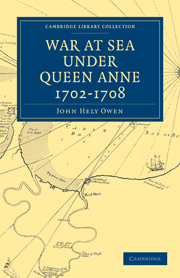Book contents
- Frontmatter
- Contents
- PLATES, CHARTS AND PLANS
- PREFACE
- METHOD OF DATING
- Chapter I Means and Ways: The Instrument
- Chapter II Ways and Means: The Use of the Instrument
- Chapter III Mediterranean Outline: Cadiz to Port Mahon
- Chapter IV The French Squadronal Attack on the Trade in the Channel Soundings, 1704
- Chapter V Barcelona, 1705
- CHAPTER VI Toulon, 1707
- CHAPTER VII Cruisers and Convoys in 1707
- CHAPTER VIII “The Alarm from Dunkirk”, 1708
- A Particulars of Typical Ships of Queen Anne's Navy
- B State of Her Majesty's Ships in Commission
- C Confederate Ships of the Line at Home and in the Mediterranean 1702 to 1710
- D State of the French Navy
- E Admiral Fairborne's Proposal for the Main Fleet in 1703
- F The Cruisers and Convoys Act, 1708
- Notes
- Index
- Plate section
Chapter II - Ways and Means: The Use of the Instrument
Published online by Cambridge University Press: 05 July 2011
- Frontmatter
- Contents
- PLATES, CHARTS AND PLANS
- PREFACE
- METHOD OF DATING
- Chapter I Means and Ways: The Instrument
- Chapter II Ways and Means: The Use of the Instrument
- Chapter III Mediterranean Outline: Cadiz to Port Mahon
- Chapter IV The French Squadronal Attack on the Trade in the Channel Soundings, 1704
- Chapter V Barcelona, 1705
- CHAPTER VI Toulon, 1707
- CHAPTER VII Cruisers and Convoys in 1707
- CHAPTER VIII “The Alarm from Dunkirk”, 1708
- A Particulars of Typical Ships of Queen Anne's Navy
- B State of Her Majesty's Ships in Commission
- C Confederate Ships of the Line at Home and in the Mediterranean 1702 to 1710
- D State of the French Navy
- E Admiral Fairborne's Proposal for the Main Fleet in 1703
- F The Cruisers and Convoys Act, 1708
- Notes
- Index
- Plate section
Summary
England and the Dutch Provinces joined the Grand Alliance for “reducing the exorbitant power of France” in 1701 with an object that was in essence defensive. They had no positive desire to see a German upon the throne of Spain; but they dreaded French dominion over western Europe and across the Atlantic. England has always felt herself vulnerable through the Low Countries, and both Powers feared the loss of their trade in the Mediterranean and farther afield. The English Parliament, sulking against King William III and tired of war, changed temper the moment Louis XIV seized the barrier fortresses in the Netherlands and a French company acquired the “Asiento”, the right of trading in the Spanish Indies, while Louis's recognizing “King James III”, with all that it implied, roused the nation behind Parliament. In July 1701, Marlborough was at the Hague, arranging the detailed terms of the Alliance, with instructions from King William enjoining him, “in the treaties you shall make, particular regard must be had to the security and improvements of the trade of our kingdoms”. He wrote to Godolphin, “I endeavoured to let the Pensionary [of Holland] see that no treaty of this kind would be acceptable in England, if there were not care taken of the Mediterranean and the West Indies.” Thus, the war of the Spanish Succession, as Professor Seeley reminds us, was the most businesslike of all our eighteenth-century wars; it was waged in the interests of English and Dutch merchants whose trade and livelihood were at stake.
- Type
- Chapter
- Information
- War at Sea Under Queen Anne 1702–1708 , pp. 34 - 70Publisher: Cambridge University PressPrint publication year: 2010First published in: 1938



